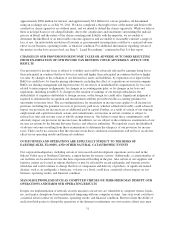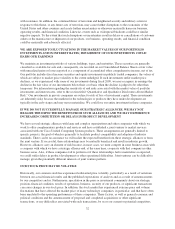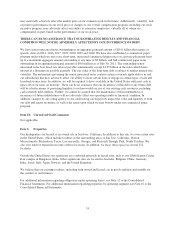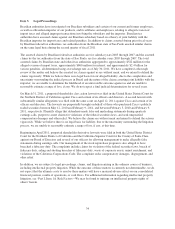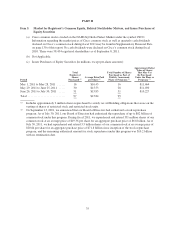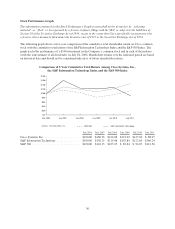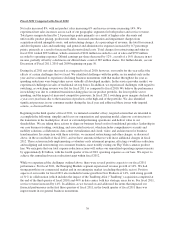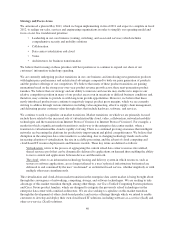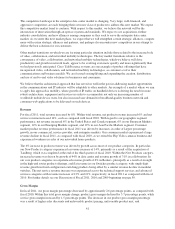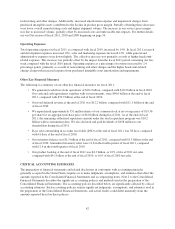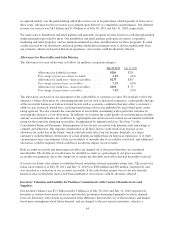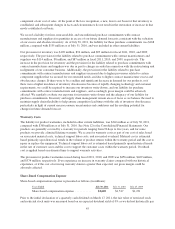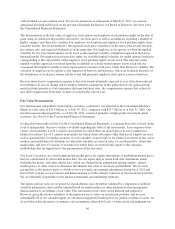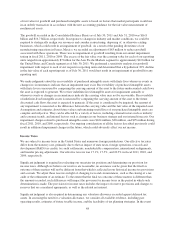Cisco 2011 Annual Report Download - page 48
Download and view the complete annual report
Please find page 48 of the 2011 Cisco annual report below. You can navigate through the pages in the report by either clicking on the pages listed below, or by using the keyword search tool below to find specific information within the annual report.
Strategy and Focus Areas
We announced a plan in May 2011, which we began implementing in fiscal 2011 and expect to complete in fiscal
2012, to realign our sales, services and engineering organizations in order to simplify our operating model and
focus on our five foundational priorities:
• Leadership in our core business (routing, switching, and associated services) which includes
comprehensive security and mobility solutions
• Collaboration
• Data center virtualization and cloud
• Video
• Architectures for business transformation
We believe that focusing on these priorities will best position us to continue to expand our share of our
customers’ information technology spending.
We are currently undergoing product transitions in our core business and introducing next-generation products
with higher price performance and architectural advantages compared to both our prior generation of products
and the product offerings of our competitors. We believe that many of these product transitions are gaining
momentum based on the strong year-over-year product revenue growth across these next-generation product
families. We believe that our strategy and our ability to innovate and execute may enable us to improve our
relative competitive position in many of our product areas even in uncertain or difficult business conditions and,
therefore, may continue to provide us with long-term growth opportunities. However, we believe that these
newly introduced products may continue to negatively impact product gross margins, which we are currently
striving to address through various initiatives including value engineering, effective supply chain management,
and delivering greater customer value through offers that include hardware, software, and services.
We continue to seek to capitalize on market transitions. Market transitions on which we are primarily focused
include those related to the increased role of virtualization/the cloud, video, collaboration, networked mobility
technologies and the transition from Internet Protocol Version 4 to Internet Protocol Version 6. For example, a
market in which a significant market transition is under way is the enterprise data center market, where a
transition to virtualization/the cloud is rapidly evolving. There is a continued growing awareness that intelligent
networks are becoming the platform for productivity improvement and global competitiveness. We believe that
disruption in the enterprise data center market is accelerating, due to changing technology trends such as the
increasing adoption of virtualization, the rise in scalable processing, and the advent of cloud computing and
cloud-based IT resource deployments and business models. These key terms are defined as follows:
Virtualization: refers to the process of aggregating the current siloed data center resources into unified,
shared resource pools that can be dynamically delivered to applications on demand thus enabling the ability
to move content and applications between devices and the network.
The cloud: refers to an information technology hosting and delivery system in which resources, such as
servers or software applications, are no longer tethered to a user’s physical infrastructure but instead are
delivered to and consumed by the user “on demand” as an Internet-based service, whether singularly or with
multiple other users simultaneously.
This virtualization and cloud-driven market transition in the enterprise data center market is being brought about
through the convergence of networking, computing, storage, and software technologies. We are seeking to take
advantage of this market transition through, among other things, our Cisco Unified Computing System platform
and Cisco Nexus product families, which are designed to integrate the previously siloed technologies in the
enterprise data center with a unified architecture. We are also seeking to capitalize on this market transition
through the development of other cloud-based product and service offerings through which we intend to enable
customers to develop and deploy their own cloud-based IT solutions, including software-as-a-service (SaaS) and
other-as-a-service (XaaS) solutions.
40



